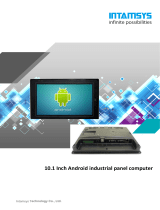
Table of Contents
1. INTRODUCTION ..............................................................................................................................................................3
1.1 PACKAGE LIST & RELEASE NOTE ................................................................................................................................3
1.2 WHY ETHERNET SOLUTIONS?......................................................................................................................................4
1.3 WHY VXCOMM TECHNOLOGY?...................................................................................................................................5
1.4 WHY XSERVER TECHNOLOGY?....................................................................................................................................9
1.5 WHY WEB SERVER TECHNOLOGY?............................................................................................................................11
1.6 7188EX, 7188EA & 7188EN SERIES........................................................................................................................12
2. TYPICAL APPLICATIONS OF 7188E SERIES..........................................................................................................13
2.1 RS-232/485/422 DEVICES NETWORKING ..................................................................................................................13
2.2 ETHERNET I/O APPLICATIONS ...................................................................................................................................16
2.3 LINK 7000 SERIES MODULES TO ETHERNET ..............................................................................................................18
2.4 CONTROL THOUSANDS OF I/O BY SINGLE-PC............................................................................................................21
2.5 CONNECT RS-232/422/485 DEVICES & I/O SIGNALS ................................................................................................23
2.6 CONFIGURABLE ETHERNET DATA LOGGER................................................................................................................24
3. DIAGNOSTICS OF THE 7188E SERIES......................................................................................................................26
3.1 APPLY POWER TO 7188E ...........................................................................................................................................26
3.2 LINKING TO PROGRAM-DEVELOPMENT PC................................................................................................................30
3.3 CONFIGURE WIZARD..................................................................................................................................................33
4. I/O EXPANSION BUS FOR 7188E SERIES.................................................................................................................40
4.1 DEFINITION ................................................................................................................................................................42
4.2 PARALLEL BUS ..........................................................................................................................................................44
4.3 SERIAL BUS................................................................................................................................................................49
5. HARDWARE INFORMATION......................................................................................................................................54
5.1 FEATURES ..................................................................................................................................................................54
5.2 PIN ASSIGNMENT .......................................................................................................................................................55
5.3 SPECIFICATIONS.........................................................................................................................................................73
5.4 BLOCK DIAGRAM.......................................................................................................................................................78
5.5 THE WIRE CONNECTION OF 7188EN SERIES .............................................................................................................81
5.6 DIMENSION AND MOUNTING......................................................................................................................................87
7188E Series Hardware User’s Manual, 2004, v2.2, 7MH-016-22 ----- 2






















